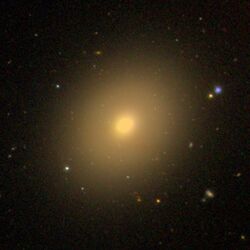Astronomy:NGC 3998
Coordinates: ![]() 11h 57m 56.1333s, +55° 27′ 12.922″
11h 57m 56.1333s, +55° 27′ 12.922″
| {{{name}}} | |
|---|---|
 SDSS image of NGC 3998 | |
| Observation data (J2000 epoch) | |
| Constellation | Ursa Major |
| Right ascension | 11h 57m 56.1333s[1] |
| Declination | +55° 27′ 12.922″[1] |
| Redshift | 0.00350[1] |
| Helio radial velocity | 1048 ± 5 km/s[1] |
| Distance | 45 Mly (13.7 Mpc)[2] |
| Apparent magnitude (V) | 12.10[3] |
| Apparent magnitude (B) | 11.64[4] |
| Absolute magnitude (V) | 2.7′ × 2.3′[5] |
| Characteristics | |
| Type | SA00(r):[1] |
| Other designations | |
| UGC 6946, MCG+09-20-046, PGC 37642[1] | |
NGC 3998 is a lenticular galaxy located in the constellation Ursa Major. It was discovered on April 14, 1789, by the astronomer William Herschel.[5] At a distance of 45 million light-years (13.7 megaparsecs),[2] it is located relatively nearby, making it a well-studied object.[6]
In Gérard de Vaucouleurs' atlas of galaxy morphological types, NGC 3998 has a classification of SA00(r):, meaning it is unbarred and has an internal ring.[5] It is classified as a LINER-type galaxy.[6] As an early-type galaxy, NGC 3998's stars are relatively old and reddish in color, but its nuclear region may still have signs of star formation with stars less than 10 million years old.[6] The galaxy's shape is very round, and also oblate.[2]
Structure
NGC 3998 contains an active galactic nucleus, or AGN. These are supermassive black holes that are surrounded by accretion disks that emit large amounts of energy across the electromagnetic spectrum. The supermassive black hole has been modeled to be about 8.1+2.0
−1.9×108 M☉[2] The AGN's power is relatively low, and like most other low-power radio galaxies, most of its emission is concentrated near its core. However, it also has some S-shaped lobes of emission, which are quite young and active, at only a few tens of millions of years old.[7]
NGC 3998 has a small disk of ionized Hα radiation that is about 100 parsecs wide, along with a larger, warped disk of neutral hydrogen. It is thought that the gas disk has just started to align with the stellar distribution, which would also explain the warped shape of the radio emission.[6][7]
References
- ↑ Jump up to: 1.0 1.1 1.2 1.3 1.4 1.5 "Results for object NGC 3998 (NGC 3998)". NASA/IPAC Extragalactic Database. California Institute of Technology. https://ned.ipac.caltech.edu/byname?objname=NGC%203998&hconst=67.8&omegam=0.308&omegav=0.692&wmap=4&corr_z=1. Retrieved 2021-04-25.
- ↑ Jump up to: 2.0 2.1 2.2 2.3 Walsh, Jonelle L.; Van Den Bosch, Remco C. E.; Barth, Aaron J.; Sarzi, Marc (2012). "A Stellar Dynamical Mass Measurement of the Black Hole in NGC 3998 from Keck Adaptive Optics Observations". The Astrophysical Journal 753 (1): 79. doi:10.1088/0004-637X/753/1/79. Bibcode: 2012ApJ...753...79W.
- ↑ Véron-Cetty, M.-P.; Véron, P. (2010). "A catalogue of quasars and active nuclei". Astronomy and Astrophysics 518: A10. doi:10.1051/0004-6361/201014188. Bibcode: 2010A&A...518A..10V.
- ↑ "NGC 3998". SIMBAD. Centre de données astronomiques de Strasbourg. http://simbad.u-strasbg.fr/simbad/sim-basic?Ident=NGC+3998.
- ↑ Jump up to: 5.0 5.1 5.2 Seligman, Courtney. "New General Catalogue objects: NGC 3950 - 3999". http://cseligman.com/text/atlas/ngc39a.htm#3998. Retrieved 2021-04-25.
- ↑ Jump up to: 6.0 6.1 6.2 6.3 Frank, Bradley S.; Morganti, Raffaella; Oosterloo, Tom; Nyland, Kristina; Serra, Paolo (2016). "A rare example of low surface-brightness radio lobes in a gas-rich early-type galaxy: The story of NGC 3998". Astronomy & Astrophysics 592: A94. doi:10.1051/0004-6361/201628282. Bibcode: 2016A&A...592A..94F.
- ↑ Jump up to: 7.0 7.1 Sridhar, Sarrvesh S.; Morganti, Raffaella; Nyland, Kristina; Frank, Bradley S.; Harwood, Jeremy; Oosterloo, Tom (2020). "LOFAR view of NGC 3998, a sputtering AGN". Astronomy & Astrophysics 634: A108. doi:10.1051/0004-6361/201936796. Bibcode: 2020A&A...634A.108S.
External links
 |

